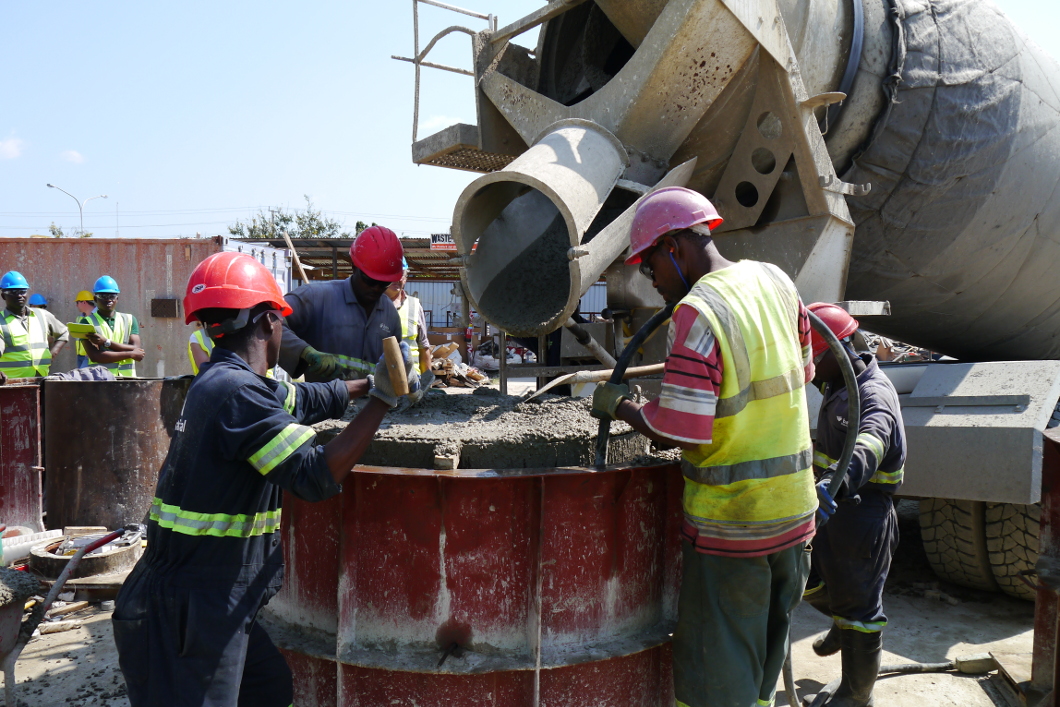
Working with ready-mixed concrete at a construction site in Tanzania. The individual components of the concrete are often mixed on site.
Source: BAM, DivisionTechnology of Construction Materials
Africa's emerging construction industry can become a global role model for sustainable construction. Together with their local partners, BAM’s researchers are developing bio-based concrete on site, for which even waste from agriculture can be used. The interest is huge: as much concrete is used on Africa's construction sites today as in Europe – and the demand will grow.
Every time he visits an African country, Dr. Wolfram Schmidt from BAM’s Technology of Construction Materials division sees how the skylines and the streets of the big cities are changing; industry is booming in many countries of the continent. "There are many construction projects and, as a consequence, the demand for concrete is growing rapidly," says the scientist. BAM coordinates numerous projects on the topic of bio-based concrete on the continent so Schmidt frequently travels on research trips and to conferences in South Africa, Nigeria, Tanzania, Ghana and Kenya. Schmidt is convinced that "Africa could show us all how to build more sustainably".
More sustainable – in this case means lower CO2 emissions and the use of local and renewable resources. Concrete requires considerable amounts of cement as a binder which produces very large quantities of the greenhouse gas carbon dioxide. "Concrete is one of the most commonly used commodities on earth and if we manage to save even a few percent of CO2 emissions, that will have a significant impact on the fight against climate change," says Schmidt.
Suitable concepts for Africa
One option to develop sustainable concrete is to reduce the proportion of cement and instead mix substances with similar properties to the building material. Fly ash from hard coal combustion and blast-furnace slag from iron ore mining are already used worldwide. However, none of them are available in Africa. "We have to look for suitable local alternatives instead of shipping blast-furnace slag from Asia to East Africa, as is currently happening," explains Schmidt.
The solutions that BAM is developing together with its African research partners therefore always consider the regional conditions. "In a project in Nigeria, we use the husk of the cassava plant root which is very commonly grown in West Africa," says Schmidt. Cassava feeds half a billion people world-wide, their roots are known here as Manioc. "The husks are a real environmental problem," explains Schmidt. "They are dumped on heaps, attract insects, develop an unpleasant odour and can pollute the groundwater."
Plant components improve concrete
BAM is cooperating with Kolawole Adisa Olonade, professor at the University of Lagos, Nigeria, who has been researching the recovery of cassava husks for several years using combustion. "The ash contains large amounts of silica and alumina and is therefore well suited as a cement substitute in concrete," says Schmidt.
Together with Olonade, BAM scientists want to find out how ash as a cement substitute changes the concrete. They investigate the processing options and the influence of the cassava additive on consistency, compressive strength, the tendency to crack and the durability of concrete. "In order to evaluate the entire potential of bio-based concrete, we need a sound basis," explains Schmidt: "If we control the combustion process properly, cassava as a concrete component can even perform better than the classic Portland cement," says Schmidt.
Even before the husks are fed into the oven, they are boiled at about 70 degrees Celsius to extract their starch content. This improves the processing properties of concrete and ensures that water evaporates more slowly when hardening – a welcome effect in hot Africa. The different climate is only one aspect that the BAM team investigate in their research, Schmidt describes another: "In Africa, the individual components are often delivered in sacks or as bulk material to the construction site, stored and only mixed on site even in the construction of multi-storey buildings so that the quality of concrete depends much more on external factors than in Germany."
Create regional networks
Together with researchers from the University of Lagos, headed by Olonade, Schmidt currently investigates how decision makers and the regional industry can be integrated. They also interview the local farmers. "Together with our local partners, we may be able to ignite a spark," says Schmidt. "It is important to us to credibly demonstrate to the local market participants how waste materials recovery can create new value chains regionally."
West African countries need industrial production processes, better infrastructure and a whole new generation of engineers and scientists to deploy sustainable construction techniques on a large scale. BAM is developing new methods for training engineers for future construction using sustainable materials with its partners in Nigeria, Cameroon, Kenya and South Africa.
The first great success of the collaboration is already visible: the research into bio-based concrete was awarded the German African Innovation Incentive Award by the Federal Ministry of Education and Research in 2018. The money will be used to build the first cassava concrete building: a bus shelter on the campus of the University of Lagos which will also serve as an information centre for sustainable construction.


